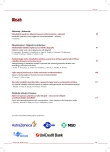Pathophysiology of metabolic acidosis in patients with reduced glomerular filtration rate according to Stewart-Fencl theory
Authors:
J. Havlín 1; K. Matoušovic 1; O. Schück 1; M. Horáčková 1; J. Charvát 1; K. Kotaška 2
; D. Králová 1
Authors‘ workplace:
Interní klinika 2. lékařské fakulty UK a FN Motol Praha, přednosta prof. MUDr. Milan Kvapil, CSc., MBA
1; Ústav klinické biochemie a patobiochemie 2. lékařské fakulty UK a FN Motol Praha, přednosta prof. MUDr. Richard Průša, CSc.
2
Published in:
Vnitř Lék 2009; 55(2): 97-104
Category:
Original Contributions
Overview
Aim:
Metabolic acidosis is a regular sign of renal insufficiency. Conventional assessment of acid-base balance using Henderson-Hasselbalch equation does not make identification of the cause of metabolic disorders possible as the serum HCO3– concentration might only reflect changes to the overall plasma ion spectrum. Therefore, we used the Stewart-Fencl approach that is based on a more detailed physical and chemical analysis and that showed that changes to serum HCO3– concentration are closely related to parameters not usually monitored in connection to acid-base balance.
Patient group and methodology:
We performed a single measurement of arterial or capillary blood pH and pCO2 in 69 non-dialysed patients with glomerular filtration rate ranging from 0.04 to 0.88 ml/s/1.73 m2 according to MDRD, standard calculation of serum HCO3– concentration using Henderson-Hasselbalch equation was carried out, and serum albumin and ion concentrations (Na+, K+, Cl, Pi) plus creatinine and urea concentrations were determined from venous blood.
Results:
Metabolic acidosis was present in 47 patients ([S-HCO3–] < 22 mmol/l) with the mean [S-HCO3–] value of 19.6 mmol/l for the entire group. We proved a statistically significant correlation between [S-HCO3–] and [SID] (p < 0.001), and between [S-HCO3–] and the individual [SID] determining factors: [Na+-Cl–], [UA–], [Pi–], [K+] (p < 0.01). Conclusion: Reduction in [S-HCO3–] in non-dialysed patients with reduced glomerular filtration is predominantly associated with a decrease in [Na+-Cl–] difference, the quantitative contribution of which to metabolic acidosis is more significant than the strong acids retention. In addition to [S-Cl–] increase, [S-Na+] reduction too has a major role in reducing the [Na+-Cl–] difference.
Key words:
renal insufficiency – metabolic acidosis – Stewart theory - strong ion difference - unidentified anions - [Na+-Cl–] difference
Sources
1. Kraut JA, Kurtz I. Metabolic acidosis of CKD: diagnosis, clinical characteristics and treatment. Am J Kidney Dis 2005; 45: 978–993.
2. Wallia R, Greenberg A, Piraino B et al. Serum electrolyte patterns in end‑stage renal disease. Am J Kidney Dis 1986; 8: 98–104.
3. Hakim RM, Lazarus JM. Biochemical parameters in chronic renal failure. Am J Kidney Dis 1988; 11: 238–247.
4. Stewart PA. Modern quantitative acid-base chemistry. Can J Physiol Pharmacol 1983; 61: 1444–1461.
5. Fencl V, Leith DE. Stewart’s quantitative acid-base chemistry: Applications in biology and medicine. Respir Physiol 1993; 91: 1–16.
6. Jones NL. A quantitative physicochemical approach to acid-base physiology. Clin Biochem 1990; 23: 89–95.
7. Corey HE. Stewart and beyond: New models of acid-base balance. Kidney Int 2003; 64: 777–787.
8. Boyle M, Baldwin I. Introduction to an alternative view of acid-base balance: the strong ion difference or Stewart approach. Aust Crit Care 2002; 15: 14–20.
9. Matoušovic K, Martínek V, Kvapil M. Acidobazická rovnováha tělesných tekutin a její kvantitaivní fyzikálně‑chemické hodnocení. Aktuality v nefrologii 2002; 4: 150–156.
10. Schück O, Matoušovic K. Vztah mezi pH a diferencí silných iontů (SID) ve vnitřním prostředí. Klin Biochem Metab 2005; 34: 32–35.
11. Matoušovic K, Martínek V. Analýza a korekce poruch acidobazické rovnováhy na základě Stewartova-Fenclova principu. Vnitř Lék 2004; 7: 526–530.
12. Rosival V. Explanation of the Stewart-Fencl views on the acid-base equilibrium. Vnitř Lék 2004; 11: 877.
13. Schück O, Teplan V, Marečková O. MDRD formulas for GFR estimation. Is there any difference among them in prediction of renal inulin clearance? Clin Nephrol 2005; 64: 326–327.
14. Figge J, Jabor A, Kazda A et al. Anion gap and hypoalbuminemia. Crit Care Med 1998; 26: 1807–1810.
15. Wilkes P. Hypoproteinemia, strong ion difference, and acid-base status in critically ill patients. J Appl Physiol 1998; 5: 1740–1748.
16. Figge J, Mydosh T, Fencl V. Serum proteins and acid-base equilibria a follow up. J Lab Clin Med 1992; 120: 713–719.
17. Figge J, Rossing TH, Fencl V. The role of serum proteins in acid-base equilibria. J Lab Clin Med 1991; 117: 453–467.
18. Corey HE. The anion gap (AG): studies in the nephrotic syndrome and diabetic ketoacidosis (DKA). J Lab Clin Med 2006; 147: 121–125.
19. McAuliffe JJ, Lind LJ, Leith DE et al. Hypoproteinemic alkalosis. Am J Med 1986; 81: 86–90.
20. Story DA, Tosolini A, Bellmo R et al. Plasma acid-base changes in chronic renal failure: A Stewart analysis. Int J Art Org 2005; 28: 961–965.
Labels
Diabetology Endocrinology Internal medicineArticle was published in
Internal Medicine

2009 Issue 2
Most read in this issue
- Superficial thrombophlebitis – diagnostics and treatment
- Guidelines for duplex ultrasound exam of limb veins
- Aortic valve sparing operations and reconstruction – from anatomy to the long‑term results
- The combination of an ACE inhibitor and a calcium channel blocker is an optimal combination for the treatment of hypertension
